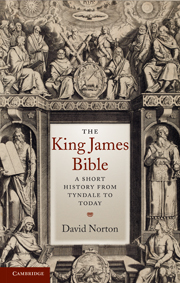Book contents
- Frontmatter
- Contents
- List of illustrations
- Preface
- List of abbreviations
- 1 Predecessors
- 2 Drafting the King James Bible
- 3 ‘I was a translator’
- 4 Working on the King James Bible
- 5 1611: the first edition
- 6 Printing, editing and the development of a standard text
- 7 Reputation and future
- Select bibliography
- Index
2 - Drafting the King James Bible
Published online by Cambridge University Press: 05 June 2012
- Frontmatter
- Contents
- List of illustrations
- Preface
- List of abbreviations
- 1 Predecessors
- 2 Drafting the King James Bible
- 3 ‘I was a translator’
- 4 Working on the King James Bible
- 5 1611: the first edition
- 6 Printing, editing and the development of a standard text
- 7 Reputation and future
- Select bibliography
- Index
Summary
JOSEPH AND MARY
In this chapter, two short passages, one from each Testament, will be examined to give an impression of how the drafting of the KJB went in practice. Each is given in modern spelling and presentation in order to make the real similarities and differences as clear as possible. This kind of study inevitably presents the work of revision as a matter of either choosing between possibilities offered by preceding drafts or rejecting them all in favour of a new version. Some of the dynamics of translation such as those revealed by Lawrence's notes are omitted as being almost impossible to trace.
Matthew 1:18–21 involves one of the first problems for a translator of the NT, how to deal with the relationship between Mary and Joseph, a matter that is particularly difficult if the translator is unable to give a note explaining the theological and social background. Here is the first draft of the KJB, Tyndale's 1525/6 version:
The birth of Christ was on this wise, when his mother Mary was married unto Joseph, before they came to dwell together, she was found with child by the holy Ghost. Then her husband Joseph, being a perfect man, and loath to defame her, was minded to put her away secretly. While he thus thought, behold, the angel of the Lord appeared unto him in his sleep, saying, ‘Joseph the son of David, fear not to take unto thee, Mary thy wife. For that which is conceived in her, is of the holy Ghost. […]
- Type
- Chapter
- Information
- The King James BibleA Short History from Tyndale to Today, pp. 33 - 53Publisher: Cambridge University PressPrint publication year: 2011



